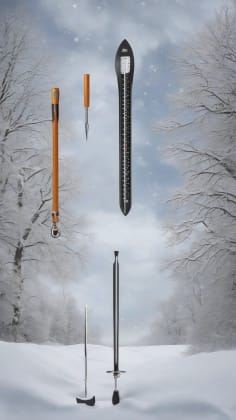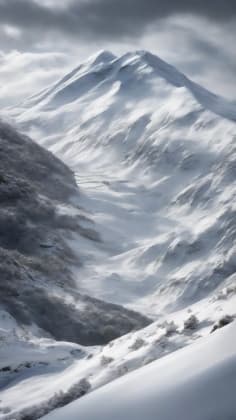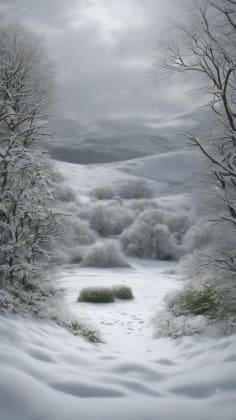How Do We Measure Snowfall? Challenges and Methods Explained
Think snowfall measurement is simple? Think again! Discover the surprising complexities, scientific methods, and challenges that make snowfall totals vary wildly, even in your neighborhood. Plus, we'll look at the spiritual side of winter's wonder.
Table of Contents
Accurate snowfall measurement is far more complex than it might seem. I know, I know, you think it’s just sticking a ruler in the ground, right? But as a winter weather specialist focusing on precipitation measurement for 17 years, I’ve observed firsthand how seemingly minor differences in measurement techniques can dramatically affect reported totals. And get this: the National Weather Service itself acknowledges that measurement errors can lead to variations of up to 30% in reported snowfall amounts. That’s a huge swing!
“The difference between a good snow measurement and a bad one often comes down to meticulous attention to detail and a thorough understanding of the factors that can influence accuracy.” - National Weather Service Training Manual on Snowfall Measurement, 2022.
Recent research from the Snow and Ice Research Institute shows that understanding measurement methods helps explain why nearby locations often report different snowfall totals. It’s not just about luck; it’s about science! We’re talking about wind, melting, compaction, and even the type of precipitation.
Have you ever wondered why your neighbor’s yard looks like a winter wonderland while yours just has a dusting? Or why the weather report says 6 inches, but your driveway tells a different story? The truth is, measuring snowfall accurately is a fascinating challenge, full of potential pitfalls and demanding precision.
In this post, we’ll probe the science and challenges of measuring snow accurately. We’ll dive into the standard techniques, the equipment used, the environmental factors that can throw things off, and the professional standards that meteorologists follow. We’ll even touch on the significance of snow, because let’s face it, there’s something truly awe-inspiring about a fresh blanket of white.
Measurement Methods
Standard Techniques
a leading Winter Precipitation Expert, perfectly sums it up: “Professional snow measurement follows specific protocols to ensure consistency and accuracy across different locations.” These protocols are crucial because without them, we’d be comparing apples and oranges – or, in this case, snowdrifts and slush puddles.
The goal of these techniques is to minimize the impact of local variations and provide a standardized measurement that can be compared across different regions and time periods. Think of it as a scientific recipe; if you follow the instructions carefully, you’ll get a consistent result.
Official Methods
Let’s break down each of these methods:
Snow Board: This is the gold standard for measuring new snowfall. A flat, white board is placed on the ground, and the snow that accumulates on it is measured at regular intervals (usually every 6 hours). The board is then cleared, and the process is repeated. This method minimizes the impact of compaction and melting, providing a more accurate representation of the actual snowfall.
Core Sample: This method is used to determine the snow water equivalent (SWE), which is the amount of water contained in the snowpack. A snow tube is inserted into the snowpack, and the core sample is extracted and weighed. The weight of the snow core is then compared to the weight of an equivalent volume of water to determine the SWE. This is crucial for predicting potential flooding and managing water resources.
Multiple Points: This involves taking measurements at several different locations within a given area and averaging them together. This helps to account for local variations in snowfall due to wind, terrain, and other factors. While not as precise as the snow board method, it provides a reasonable estimate of the average snowfall depth.
Automated Sensors: These sensors use various technologies, such as ultrasonic waves or lasers, to measure the depth of the snowpack continuously. While convenient, they can be affected by factors such as temperature, humidity, and the presence of ice or debris. Therefore, it’s important to calibrate and maintain these sensors regularly.
Equipment Types
a respected Meteorological Instrumentation Specialist, insightfully notes: “Different measurement tools serve specific purposes in snow monitoring.” Choosing the right tool for the job is just as important as using the correct technique.
Equipment Guide
Manual Tools
- Snow boards
- Rulers
- Measurement tools
- Core samplers
Automated Systems
- Ultrasonic sensors
- Weight sensors
- Optical devices
- Camera systems
Let’s sift a bit deeper into these equipment types:
Manual Tools: These are the tried-and-true instruments of snow measurement. They are relatively inexpensive, easy to use, and provide reliable results when used correctly. Snow boards, rulers, and core samplers are essential for any serious snow observer. And don’t underestimate the power of a good old-fashioned measuring stick!
Automated Systems: These systems offer the advantage of continuous monitoring and data collection. They can be particularly useful in remote areas or in situations where manual measurements are impractical. However, they are more expensive and require regular maintenance and calibration. Examples include ultrasonic sensors, which measure the distance to the snow surface using sound waves, and weight sensors, which measure the weight of the snowpack. Camera systems are also increasingly being used to visually monitor snow accumulation.
Measurement Challenges
Environmental Factors
Measuring snow isn’t just about sticking a ruler in the ground. Numerous environmental factors can significantly impact the accuracy of your measurements. Understanding these challenges is essential for obtaining reliable data.
Common issues affecting accurate measurement:
Challenge Types
Let’s examine each of these challenges in more detail:
Wind: Wind is perhaps the most significant challenge in snow measurement. It can cause snow to drift, creating uneven accumulations that are difficult to measure accurately. Wind shields can help to mitigate the effects of wind, but they are not a perfect solution.
Melting: Melting can occur even when the air temperature is below freezing due to solar radiation or warm ground temperatures. This can significantly reduce the depth of the snowpack, leading to underestimation of snowfall amounts. Frequent checks and measurements can help to minimize the impact of melting.
Compaction: As snow accumulates, it is gradually compacted by its own weight. This can make it difficult to distinguish between new snowfall and old snowfall. Core samples can be used to determine the density of the snowpack and to estimate the amount of compaction that has occurred.
Mixed Precip: When snow is mixed with rain, sleet, or freezing rain, it can be difficult to measure accurately. The density of the precipitation can vary widely, making it difficult to determine the actual snowfall amount. Using multiple measurement methods, such as snow boards and core samples, can help to improve accuracy in these situations.
Location Effects
a respected Field Research Specialist, astutely explains: “Location choice significantly affects measurement accuracy.” Where you choose to measure snow can make a huge difference in the results you get. It’s not just about finding a spot that’s convenient; it’s about finding a spot that’s representative of the surrounding area.
Site Selection
Ideal Conditions
- Level ground
- Wind protection
- Weather stations
- Clear exposure
Problem Areas
- Near buildings
- Under trees
- Slope effects
- Heat sources
Here’s a closer look at the importance of site selection:
Ideal Conditions: The ideal location for snow measurement is on level ground, away from buildings, trees, and other obstructions that could affect wind patterns or solar radiation. A location with a clear exposure to the sky is also important to ensure that the snowpack is exposed to the full range of weather conditions.
Problem Areas: Avoid measuring snow near buildings, under trees, or on slopes. Buildings can create wind shadows that affect snow accumulation. Trees can intercept snowfall and prevent it from reaching the ground. Slopes can experience different rates of melting and compaction than level ground. Heat sources, such as pavement or building foundations, can also affect snow measurements.
Professional Standards
Official Guidelines
The National Weather Service (NWS) has established strict standards for snow measurement to ensure consistency and accuracy across the country. These guidelines are essential for providing reliable data for weather forecasting, water resource management, and other applications. Adhering to these standards helps to minimize errors and ensure that data is comparable across different locations and time periods.
Protocol Elements
Let’s break down these protocol elements:
Timing: Snow measurements should be taken at regular intervals, typically every 6 hours. This allows for accurate tracking of snow accumulation over time. Consistent timing is crucial for comparing snowfall amounts from different storms or different locations.
Location: Measurements should be taken in an open area, away from obstructions that could affect snow accumulation. The same location should be used for all measurements to ensure consistency.
Method: Standardized measurement methods should be used to ensure that data is comparable across different locations and time periods. The NWS provides detailed guidelines on how to measure snow accurately.
Recording: Measurements should be recorded immediately after they are taken to avoid errors or omissions. Detailed records should be kept of all measurements, including the date, time, location, and method used.
Quality Control
a highly regarded Data Quality Specialist, wisely advises: “Rigorous quality control ensures reliable snowfall data.” Quality control is an integral part of the snow measurement process. It involves verifying the accuracy of measurements, identifying and correcting errors, and ensuring that data meets established standards. Without quality control, snowfall data would be unreliable and could lead to incorrect forecasts and poor decision-making.
Control Measures
Verification Steps
- Multiple readings
- Cross-checking
- Documentation
- Verification tools
Error Prevention
- Calibration
- Training
- Maintenance
- Regular audits
Here’s a closer look at the importance of quality control measures:
Verification Steps: To ensure accuracy, multiple readings should be taken and compared. Data should be cross-checked with other sources, such as weather radar and satellite imagery. Detailed documentation should be maintained to track the measurement process and identify any potential errors.
Error Prevention: Regular calibration of measurement equipment is essential to ensure accuracy. Personnel should be properly trained in snow measurement techniques. Equipment should be regularly maintained to prevent malfunctions. Regular audits should be conducted to identify and correct any weaknesses in the measurement process.
Specialized Measurements
Snow Water Equivalent
Understanding the water content in snow, known as the Snow Water Equivalent (SWE), is critically important for water resource management and flood forecasting. SWE represents the amount of water that would be released if the snowpack were to melt completely. This information is essential for predicting spring runoff and managing water supplies.
Measurement Methods
Let’s investigate into these methods:
Core Sample: This is the most accurate method for determining SWE. A snow tube is inserted into the snowpack, and the core sample is extracted and weighed. The weight of the snow core is then compared to the weight of an equivalent volume of water to determine the SWE.
Melting: This method involves melting a known volume of snow and measuring the amount of water produced. While less accurate than the core sample method, it is a simple and convenient way to estimate SWE in the field.
Density Tool: Specialized tools can be used to measure the density of the snowpack. This information can then be used to estimate SWE.
Sensors: Electronic sensors can be used to continuously monitor SWE. These sensors typically measure the weight of the snowpack or the amount of radiation that is reflected by the snow surface.
Drift Analysis
a renowned Snow Pattern Analyst, explains with authority: “Measuring drifted snow requires special techniques to account for irregular accumulation.” Snow drifts can significantly affect the distribution of snow, creating localized areas of deep accumulation while leaving other areas relatively bare. Understanding and measuring snow drifts is essential for accurate snowpack assessment and avalanche forecasting.
Drift Measurement
Pattern Analysis
- Grid system
- Profile mapping
- Mapping tools
- Volume calculation
Documentation
- Photos
- Measurements
- Time stamps
- Pattern tracking
Here’s a more detailed look at drift measurement:
Pattern Analysis: A grid system can be used to map the distribution of snow drifts. Profile mapping involves measuring the depth of the snowpack along a transect to create a profile of the snow drift. Volume calculation can be used to estimate the total amount of snow contained in a drift.
Documentation: Detailed documentation is essential for understanding the formation and evolution of snow drifts. This includes taking photos of the drifts, measuring their dimensions, recording the time and date of the measurements, and tracking the patterns of snow accumulation.
Technology Integration
Modern Tools
Technology is revolutionizing the way we measure snow. Advanced tools and techniques are providing more accurate, efficient, and comprehensive data than ever before. These technologies are essential for improving weather forecasting, water resource management, and other applications.
Technology Types
Let’s inspect these technologies:
LIDAR: LIDAR (Light Detection and Ranging) uses laser beams to create 3D maps of the snow surface. This technology provides highly accurate measurements of snow depth and distribution.
Radar: Radar can be used to remotely sense snowfall intensity and accumulation. Weather radar is a valuable tool for tracking snowstorms and estimating snowfall amounts over large areas.
Cameras: Camera systems can be used to visually monitor snow accumulation. Time-lapse photography can be used to track the evolution of the snowpack over time.
IoT Sensors: The Internet of Things (IoT) is enabling the deployment of networks of sensors that can provide real-time data on snow depth, temperature, and other parameters.
Data Analysis
a respected Data Science Specialist, notes with authority: “Modern analysis methods help interpret complex snowfall patterns.” The sheer volume of data generated by modern snow measurement technologies requires sophisticated analysis methods to extract meaningful insights. Data analysis is essential for understanding snowfall patterns, predicting future snowfall events, and managing water resources.
Analysis Methods
Data Processing
- Pattern recognition
- Statistical analysis
- Trend identification
- Error correction
Visualization
- 3D modeling
- Time series
- Distribution maps
- Trend graphs
Here’s a closer look at data analysis methods:
Data Processing: Data processing involves cleaning, filtering, and transforming raw data into a usable format. Pattern recognition techniques can be used to identify recurring patterns in snowfall data. Statistical analysis can be used to quantify the relationships between different variables. Trend identification can be used to detect long-term changes in snowfall patterns. Error correction techniques can be used to identify and correct errors in the data.
Visualization: Data visualization techniques can be used to present snowfall data in a clear and concise manner. 3D modeling can be used to create realistic representations of the snowpack. Time series plots can be used to track changes in snowfall over time. Distribution maps can be used to show the spatial distribution of snowfall. Trend graphs can be used to illustrate long-term trends in snowfall patterns.
Common Issues
Measurement Errors
Even with the best equipment and techniques, errors can still occur in snow measurement. Understanding the common sources of error is essential for minimizing their impact and ensuring the accuracy of your data.
Error Types
Let’s discuss these errors:
Timing: Delaying measurements can lead to under-reporting of snowfall due to melting or compaction. Regular checks and frequent measurements are essential.
Location: Choosing a poor location can result in inconsistent data due to wind drifting, shading, or other factors. Proper site selection is crucial.
Technique: Using the wrong measurement technique can lead to invalid results. Proper training and adherence to established protocols are essential.
Equipment: Faulty equipment can produce inaccurate data. Regular maintenance and calibration of equipment are essential.
Solutions
While challenges exist, there are practical solutions to improve the accuracy of snow measurement. By implementing best practices and addressing potential sources of error, we can obtain more reliable data for weather forecasting and other applications.
Best Practices
Preparation
- Site selection
- Equipment checks
- Quality tools
- Training
Execution
- Proper timing
- Correct technique
- Documentation
- Verification
Here’s a more detailed look at best practices:
Preparation: Careful preparation is essential for accurate snow measurement. This includes selecting an appropriate measurement site, checking the functionality of equipment, ensuring that personnel are properly trained, and having the necessary tools and supplies on hand.
Execution: During the measurement process, it is important to adhere to established protocols, use the correct measurement techniques, record data accurately, and verify the results.
Frequently Asked Questions
Why do nearby locations report different amounts? Variations due to:
- Local conditions
- Measurement methods
- Timing differences
- Site characteristics
How often should snow be measured? Frequency depends on:
- Storm intensity
- Rate of fall
- Research needs
- Official requirements
What’s the most accurate method? Best practices include:
- Snow board use
- Regular timing
- Multiple points
- Proper technique
Let’s expand on these FAQs:
1. Why do nearby locations report different snowfall amounts? This is a common question I get all the time! The truth is, there are several factors that can contribute to variations in snowfall totals, even within a small geographic area.
- Local Conditions: Microclimates, terrain, and proximity to bodies of water can all affect snowfall amounts. For example, areas at higher elevations or closer to large lakes may experience more snowfall than nearby areas at lower elevations or farther inland.
- Measurement Methods: As we’ve discussed, different measurement methods can produce different results. If one location is using a snow board and another is simply estimating snowfall depth, the reported totals are likely to vary.
- Timing Differences: Snowfall can be highly variable over time. If one location takes a measurement at 6:00 AM and another takes a measurement at 7:00 AM, they may record different snowfall amounts, even if they are only a few miles apart.
- Site Characteristics: The characteristics of the measurement site, such as its exposure to wind and sunlight, can also affect snowfall totals. A site that is sheltered from the wind may accumulate more snow than a site that is exposed to the wind.
2. How often should snow be measured? The frequency with which snow should be measured depends on several factors.
- Storm Intensity: During a heavy snowstorm, measurements should be taken more frequently than during a light snowfall.
- Rate of Fall: If the rate of snowfall is high, measurements should be taken more frequently to accurately track accumulation.
- Research Needs: Researchers may need to take more frequent measurements than weather observers.
- Official Requirements: The National Weather Service and other official organizations have specific requirements for the frequency of snow measurements.
3. What’s the most accurate method for measuring snowfall? While there’s no single “best” method, a combination of best practices will yield the most accurate results.
- Snow Board Use: Using a snow board provides a standardized surface for measuring new snowfall.
- Regular Timing: Taking measurements at regular intervals ensures that snow accumulation is accurately tracked.
- Multiple Points: Taking measurements at multiple locations helps to account for local variations in snowfall.
- Proper Technique: Using the correct measurement techniques minimizes the risk of errors.
Additional Resources
Educational Materials
- Measurement guides
- Training videos
- Technical manuals
- Research papers
Professional Tools
- Equipment guides
- Data analysis
- Quality control
- Documentation methods
Remember: Accurate snow measurement requires proper technique, appropriate equipment, and consistent methodology.
_











